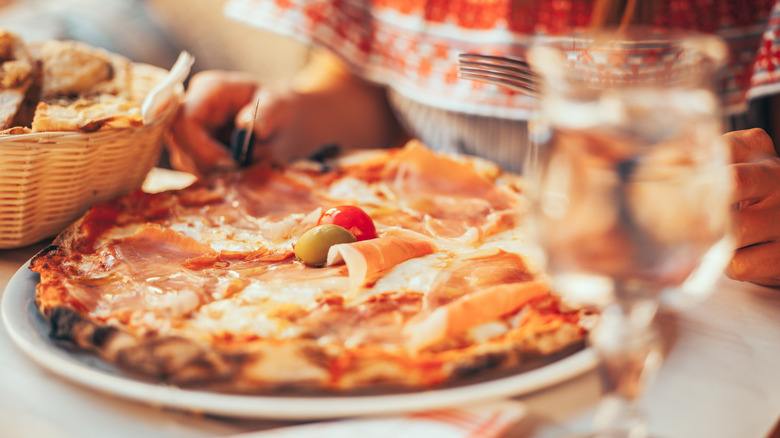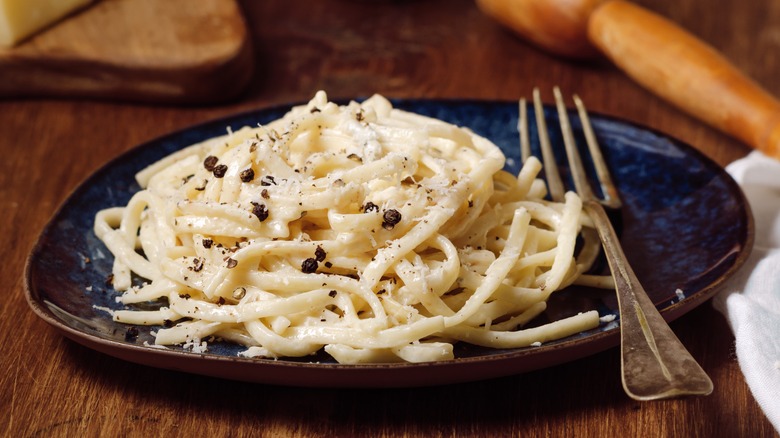If This Food Is On The Lunch Time Menu In Rome, You're Likely At A Tourist Trap Restaurant
There's nothing more embarrassing than being classified as a "tourist trap" in Italian culture, especially when it comes to their bread and butter (literally)! Sampling every bite of pizza you can find across Rome's vibrant culinary scene had better be high atop your Italian bucket list. Just make sure the pies you purchase meet the local standards. As ubiquitous as authentic trattorias and pizzerias are across Rome's cityscape, tourist traps are equally as common, attempting to pass off their food as traditional Italian staples to unsuspecting visitors. Joining a food tour in Rome can help you learn to eat like a local, but there are also a few surefire signs that indicate whether your pizzeria of choice is the real deal.
Romans eat dinner late, usually between 8 p.m. and midnight. The most obvious sign of an inauthentic Roman pizza joint is that its doors are open earlier than 7:30 p.m. While it may be a hard truth to swallow for the rest of the world, Romans reserve pizza strictly for a spot at the dinner table. So if you see it on the lunch menu, you might want to eat somewhere else. But make sure you go to dinner hungry. While mealtimes are a social activity in Italy, it's bad etiquette to order one pizza to share. It's much more common and acceptable for friends to order two different pizzas and swap slices, rather than going halves on one pie.
Save the pizza for dinner
You can easily discern the difference between traditional Roman pizza and counterfeits by looking for a good wood-fired pizza's signature elements. Professional Roman pizzaiolos have developed a highly specialized method that results in crispy, cooked-to-perfection dough that's slightly singed without ever tasting burnt. According to NPR, the secret to mastering an authentic Roman pizza rests in thermal mechanics. A short two-minute cook time at 626 degrees Fahrenheit is all it takes to create this Italian obsession. Their brick wood-fired ovens are the secret weapon, as convection ovens, and even pizza stones, just don't deliver the same results.
While it's well worth the wait, wood-fired ovens can take hours to reach the temperature levels necessary to cook the perfect pizza. Reserving whole pies strictly for dinner saves chefs the time and work of having their ovens heated and ready when the mid-day meal rolls around.
If you do come across a fully prepared pie during daytime hours, it's most likely a tourist trap hoping to come across as an authentic Roman pizzeria — practically a sin in this city. Your only hope of finding a bite of cheesy goodness melted onto crispy dough is pizza al taglio (pizza sold by the slice). These restaurants don't craft their pizza in wood-fired ovens but cater to hungry enthusiasts at all hours of the day. Just keep in mind that it most likely won't measure up to the same level of quality as you'll find at some of Italy's best pizzerias.
Lunchtime alternatives
As the proud founders of this national delicacy, Napoli (Naples) gets a pass on serving pizza for lunch. Visitors to Rome, however, are invited to indulge in other regional specialties that are just as divine as a hot-out-of-the-oven, wood-fired pizza. Pasta goes hand in hand with Roman pizza, and there are at least four pasta dishes considered Roman classics: amatriciana, carbonara, gricia, and cacio e pepe. You've probably heard of carbonara and cacio e pepe before, but have you ever tried amatriciana? Consisting of tomatoes, pecorino, chili peppers, and guanciale (cured meat), it's a heavenly take on marinara sauce. Meanwhile, gricia features a bold mix of pecorino, pepper, and guanciale — the ultimate chef's kiss.
Carciofo alla giudia is a lesser-known regional delicacy. These twice-fried artichoke hearts are often found in Rome's Jewish quarter. A divine treat in all seasons, they reach their peak flavor in Spring, freshly harvested from local fields. Napoli may hold the title of "Pizza Founder," but Rome gets the honor of boasting about their pride and joy — supplì. These crispy dough balls are stuffed to the brim with mozzarella and risotto and then fried to perfection in a fiery oven. As a classic street food, they make an easy snack. Better yet, pile on two or three and make a quick, on-the-go meal out of these tasty morsels. When visiting Rome, try one of these unique dishes for lunch, and save the real Roman pizza for dinner to avoid eating like a tourist!


